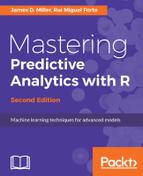The purpose of this chapter is to tackle the very important topic of deep learning and the how and why of how it has been growing in importance to the statistical field in recent years.
We will start by providing a bit of an explanation of what machine learning is then move on with some discussion around what deep learning is, how it compares to machine learning, and the reasoning behind how it has been continually growing in importance almost day by day. For clarification of the concepts, we will then present two hallmark sample use cases: word embedding with some talk about natural language processing or NLP application logic, and recurrent neural networks (RNNs) which is an interesting and more advanced and efficient type of artificial neural network.
With machine learning, algorithm options are selected and used to analyze data and data sources and, rather than make decisions on them, they learn from them so that they can use patterns or results found in the data to make decisions or predictions about a certain topic, or to solve a specific problem.
What this translates to is that instead of you programming or writing out each rule and instruction that needs to be used for a specific task such as making a prediction, the computer is trained using large amounts of data and algorithms which give it the ability to actually learn how to perform a task, make a prediction, solve a problem, or meet an objective in mind.
Note
Just how much data qualifies as enough data for successful machine learning?
Usually the bigger, the better, but in practice, you must gather a sufficient amount of data, based upon your intended purpose or need. Given a shortage of quantity, the wise data scientist should always focus on the quality or suitability of the data.
An example commonly used by experts within the field of statistics to illustrate how machine learning works is the scenario of an algorithm or model predicting a person's body weight based upon what their height happens to be. In this example, given a decent amount of experience (or actual data cases that provide a person's actual physical height and body weight), a model can be built to predict a person's body weight given their height measurements.
Obviously, the more experience (or more actual data consumed and analyzed by the model), the better the results (or predictions).
There are many kinds, or methods of machine learning, and we find that over time, the industry experts have categorized them by the type of learning the algorithm or model uses.
The typical or most common types of machine learning usually include the following:
- Supervised
- Unsupervised
- Semi-supervised
- Reinforcement
- Transduction and so on
Deep learning is different; even though machine learning is grouped by type, deep learning is not a type. Deep learning is considered a method or way of implementing machine learning.
The next section will take a closer look at that concept.
